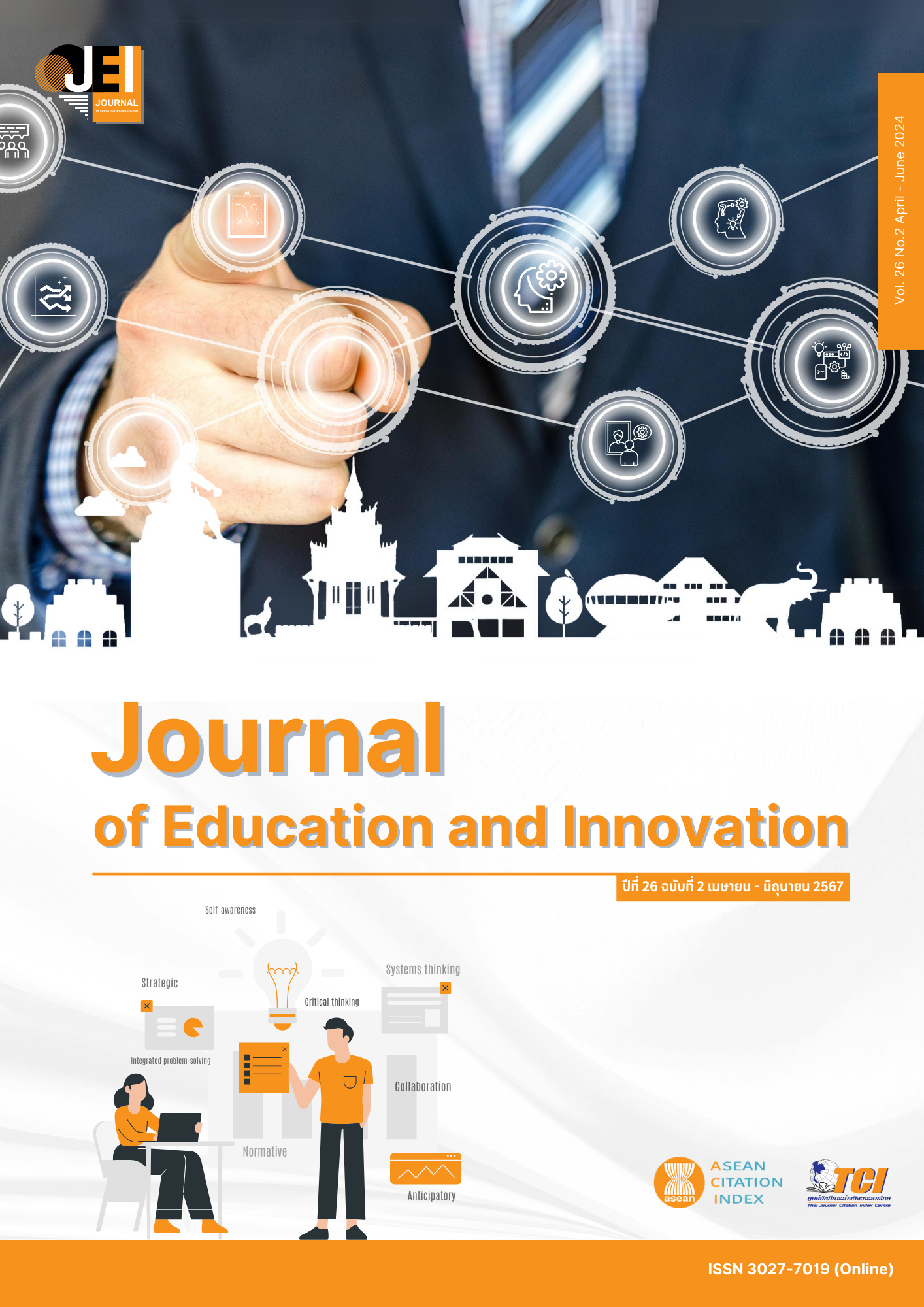กลยุทธ์การพัฒนาความมีวินัยต่อตนเองของนักเรียน สังกัดสำนักงานเขตพื้นที่การศึกษา มัธยมศึกษาชัยภูมิ
Main Article Content
บทคัดย่อ
การวิจัยครั้งนี้มีวัตถุประสงค์เพื่อ 1) ศึกษาองค์ประกอบและตัวบ่งชี้ความมีวินัยต่อตนเองของนักเรียน 2) ศึกษาสภาพปัจจุบัน สภาพที่พึงประสงค์ และความต้องการจำเป็นการพัฒนาความมีวินัยต่อตนเองของนักเรียน และ 3) พัฒนากลยุทธ์ และประเมินความเหมาะสมและความเป็นไปได้ของกลยุทธ์การพัฒนาความมีวินัยต่อตนเองของนักเรียน โดยแบ่งเป็น 3 ระยะ คือ ระยะที่ 1 ศึกษาองค์ประกอบและตัวบ่งชี้ความมีวินัยต่อตนเองของนักเรียน ระยะที่ 2 ศึกษาสภาพปัจจุบัน สภาพที่พึงประสงค์ และความต้องการจำเป็นการพัฒนาความมีวินัยต่อตนเองของนักเรียน และระยะที่ 3 พัฒนากลยุทธ์การพัฒนาความมีวินัยต่อตนเองของนักเรียน สังกัดสำนักงานเขตพื้นที่การศึกษามัธยมศึกษาชัยภูมิ กลุ่มตัวอย่าง คือ ผู้อำนวยการโรงเรียน รองผู้อำนวยการโรงเรียนที่รับผิดชอบงานกิจการนักเรียน ครูหัวหน้าฝ่ายปกครอง และครูที่ปรึกษาหรือครูประจำชั้น จำนวน 136 คน โดยวิธีการสุ่มแบบแบ่งชั้นตามขนาดสถานศึกษา เครื่องมือที่ใช้ในการวิจัยเป็นแบบสอบถามแบบมาตราส่วนประมาณค่า 5 ระดับ (Rating Scale) สถิติที่ใช้ในการวิจัย ได้แก่ ค่าเฉลี่ย ค่าเบี่ยงเบนมาตรฐาน และค่าความต้องการจำเป็น ผลการวิจัย พบว่า
1. องค์ประกอบความมีวินัยต่อตนเองของนักเรียน มี 4 ด้าน 33 ตัวบ่งชี้ ประกอบด้วย 1) ด้านความรับผิดชอบ มี 9 ตัวบ่งชี้ 2) ด้านตรงต่อเวลา มี 6 ตัวบ่งชี้ 3) ด้านปฏิบัติตามกฎ ระเบียบ ข้อบังคับ มี 8 ตัวบ่งชี้ และ 4) ด้านเคารพสิทธิผู้อื่น มี 10 ตัวบ่งชี้ ซึ่งโดยรวมองค์ประกอบทั้ง 4 ด้าน มีความเหมาะสมอยู่ในระดับมากที่สุด
2. สภาพปัจจุบันความมีวินัยต่อตนเองของนักเรียน โดยรวมอยู่ในระดับปานกลาง สภาพที่พึงประสงค์ความมีวินัยต่อตนเองของนักเรียน โดยรวมอยู่ในระดับมากที่สุด และความต้องการจำเป็น การพัฒนาความมีวินัยต่อตนเองของนักเรียนสูงสุด คือ ด้านตรงต่อเวลา รองลงมา คือ ด้านเคารพสิทธิผู้อื่น ส่วนด้านที่มีค่าต่ำสุด คือ ด้านปฏิบัติตามกฎ ระเบียบ ข้อบังคับ
3. ผลการพัฒนากลยุทธ์การพัฒนาความมีวินัยต่อตนเองของนักเรียน สังกัดสำนักงานเขตพื้นที่การศึกษามัธยมศึกษาชัยภูมิ พบว่า กลยุทธ์การพัฒนาความมีวินัยต่อตนเองของนักเรียน ที่พัฒนาโดยการสัมมนาอิงผู้เชี่ยวชาญ จำนวน 9 ท่าน ประกอบด้วย 1) วิสัยทัศน์ 2) พันธกิจ 4 ข้อ 3) เป้าประสงค์ 4 ข้อ 4) กลยุทธ์หลัก 2 กลยุทธ์ 5) กลยุทธ์รอง 6 กลยุทธ์ 6) แนวทางการนำกลยุทธ์ไปใช้ในการพัฒนา 6 แนวทางหลัก 7) กิจกรรมการพัฒนาความมีวินัยต่อตนเองของนักเรียน 6 กิจกรรมหลัก และ 8) เงื่อนไขความสำเร็จ 3 ข้อ ซึ่งมีความเหมาะสมและความเป็นไปได้ โดยรวมอยู่ในระดับมากที่สุด
Article Details

This work is licensed under a Creative Commons Attribution-NonCommercial-NoDerivatives 4.0 International License.
เจ้าของบทความมิได้คัดลอก หรือละเมิดลิขสิทธิ์ของผู้ใด หากเกิดการละเมิดลิขสิทธิ์ ไม่ว่าวิธีใด หรือการฟ้องร้องไม่ว่ากรณีใด ๆ ที่อาจเกิดขึ้นได้ กองบรรณาธิการวารสารศึกษาศาสตร์ ไม่มีส่วนเกี่ยวข้องทั้งสิ้น ให้เป็นสิทธิ์ของเจ้าของบทความที่จะดำเนินการ
References
Changklang, S, Wangphanich, P, Klinkularb, P, & Chuanchom, S. (2017). Strategic for developing self-discipine in primary student’s coast of Thailand upper southern area. NRRU Community Research Journal, 11(2), 50-65.
Office of the Education Council. (2017). National Education Plan 2017-2036. Bangkok: Prikwarn Graphic.
Office of the Education Council. (2018). Guidelines for enhancing student discipline in basic educational institutions in terms of responsibility and punctuality. Bangkok: Prikwarn Graphic.
Office of the Education Council. (2018). Research and development of the model mechanisms for enhancing discipline in basic education institutions Responsibility and punctuality. Bangkok: Prikwarn Graphic.
Office of the Education Council. (2018). Synthesis result report the result of research and development of the model mechanisms for enhancing discipline in educational institutions at the basic education level. Bangkok: Prikwarn Graphic.
Office of the Education Council. (2019). A manual for enhancing student discipline in basic education institutes regarding compliance with rules and regulations, tact and respect for other people's rights. Bangkok: Prikwarn Graphic.
Pankam, K. (2005). The participatory process use – based self-discipline development of Ban Mai Sammakkhee School Students at Office of Chiang rai Educational Service Area (Region 3) (Master thesis). Changrai: Changrai Rajabhat University.
Pantawong, S, Nantasri, W., & Phengsawat, W. (2021). Development of student discipline at Chumchonbantoom School Under Buengkan Primary Education Service Area Office. UMT Poly Journal, 18(2), 199-210.
Phoemsukrungrueang, K. (2020). The student discipline enhancing in secondary school (Doctoral dissertation). Bangkok: Silpakorn University.
Raksongmuen, S, Wisalaporn, S, Wangpanich, P, & Chuanchom, S. (2014). Factors affecting to the discipline of secondary school students in the upper southern region. Journal of Education Thaksin University, 14(2), 55-70.
Royal Gazette. (2017). Constitution of the Kingdom of Thailand, B.E. 2560. Bangkok: M.P.T.
Srisa-ard, B. (2010). New revised preliminary research (9th ed.). Bangkok: Suwiriyasarn.
Srivorakul, T, Somsrisuk, A, & Phengsawat, W. (2022). The needs assessment for discipline development of students in schools under the Office of Sakon Nakhon Primary Educational Service Area 3. Journal of Roi Kaensarn Academic, 7(10), 377-392.
Taprab, N, Phusri, S, & Thee-Asana, S. (2019). The model for student’s desired characteristics development following in private schools in Chiyaphum. Journal of Graduate MCU Khon Kaen Campus, 6(3), 548-565.
Tonglad, S. (2021). Developing guidelines for strengthening students’self-discipline under the Office of Kalasin Primary Education Area 3 (Master thesis). Maha Sarakham: Mahasarakham University.
Wongvanich, S. (2005). Needs assessment research. Bangkok: Chulalongkorn University Printing House.

